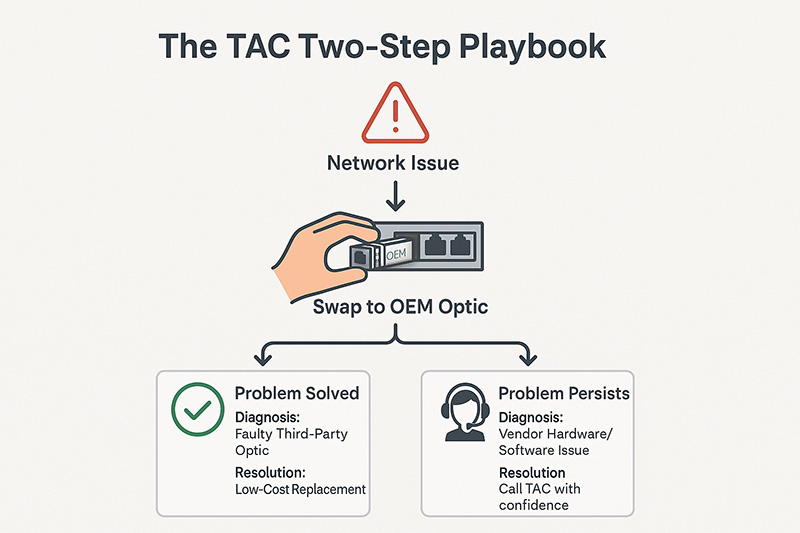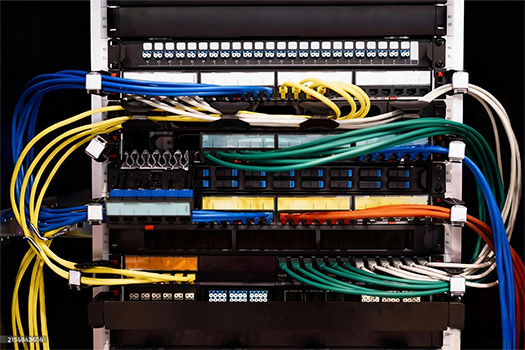A Risk-Management Playbook for MSPs, WISPs, and Integrators
We’ve all had that moment.
You’re scanning a network hardware quote, nodding along at the switch and router costs. Everything looks about right. Then, your eyes hit the line items for the optical modules.
A single, official Meraki MA-SFP-10GB-LR transceiver: $4,626 AUD.
A standard HP 10G SFP+ to RJ45 adapter: $1,300 USD.
You take a deep breath, open a new browser tab, and search for a compatible alternative. The results are jaw-dropping:
A reliable third-party version of that Meraki module costs $45.
The functional equivalent of that HP adapter is $380.
Your first reaction is perfectly normal: "This has to be a scam." It isn't. Your second thought follows immediately, and a phrase long-whispered in engineering circles comes to mind: "This is the printer ink model, isn't it?" That comparison, harsh as it sounds, perfectly captures the core of the game.

This staggering price difference isn't about superior hardware; it's a deliberate business model. Understanding this model—and knowing how to navigate it—is the key to unlocking your IT budget and redirecting tens of thousands of dollars back into your business.
This guide is a risk-management playbook. We've synthesized over a decade of real-world experience from thousands of engineers on Reddit, Spiceworks, and ServeTheHome to give you the strategy the pros use to get massive cost savings without taking foolish risks.
Deconstructing the OEM Price Tag: What Are You Really Paying For?
When you buy an OEM-branded transceiver, you're paying for much more than the hardware. It's an open secret that the physical components are often identical to their third-party counterparts, frequently rolling off the very same production lines at fabs like Finisar.
So, what does that 10x, 50x, or even 100x markup actually cover? Think of it less as an insurance policy and more as a "Support Service Pass" bundled into the hardware. This expensive pass buys you:
- The Right to Not Be Blamed: When a network issue occurs, the vendor's Technical Assistance Center (TAC) won't immediately dismiss your case because of a non-OEM part.
An Ironclad Compatibility Guarantee: The vendor certifies that this specific module has been exhaustively tested across their entire hardware and software portfolio.
Amortized R&D Costs: You're helping to fund the R&D for the entire switching platform, not just the optic.
Channel Margins & Pure Profit: It's an incredibly lucrative revenue stream, which engineers cynically refer to as a "port licensing fee in disguise."
Essentially, you're paying a premium for a simplified troubleshooting path. But is it the only path?
Facing the Fears: The Three Core Risks of Going Third-Party
If the hardware is the same, why the hesitation? Because the risks are real, and they boil down to three primary concerns voiced by engineers time and time again:
- Risk #1: The TAC Blame Game
This is the number one nightmare. A critical link is down, you're on a high-stakes call with TAC, and the first question is, "Are you using genuine SFPs?" If the answer is no, the blame game begins, and your ticket is often closed, leaving you stranded.- Risk #2: The Firmware Trap & Reliability
This is a more insidious technical risk. A vendor releases a firmware update that suddenly blacklists your previously functional third-party optics, putting ports into an err-disabled state. Beyond that, there's the fear of higher Dead-On-Arrival (DOA) rates. A more subtle but equally frustrating issue is inaccurate Digital Optical Monitoring (DOM/DDM) readings from cheap modules, which can flood your monitoring system with a constant stream of "crying wolf" alarms.- Risk #3: The Compatibility Maze
"Will a 1G SFP work in a 10G SFP+ port?" "Will this HPE-coded DAC cable talk to a Cisco Nexus switch?" The world of cross-vendor and cross-speed compatibility is a minefield for the uninitiated.
These are all valid business concerns. The good news? The engineering community has spent over a decade perfecting a simple, elegant, and effective strategy to mitigate all of them.
The Pro's Playbook: The "TAC Two-Step" Risk Management Strategy
This is the golden rule, the community-vetted best practice that allows you to safely cut over 95% of your optics budget.
The Strategy: For every critical link or module type, purchase and keep one or two pairs of genuine OEM optics to serve as your "golden standard" for troubleshooting. Run your entire day-to-day operation on modules from a reputable third-party vendor.
The Execution (The "TAC Two-Step"):
Step 1: Isolate. When a network fault occurs on a link using third-party optics, begin your standard troubleshooting.
Step 2: Validate. Before you call TAC, physically swap the third-party modules on both ends of the problematic link with your "golden standard" OEM pair.
This simple action places you in a position of absolute strength:
- Scenario A: The problem disappears. You've confirmed a rare faulty third-party module. The replacement cost is negligible(20-50), a tiny fraction of the thousands you've already saved. Swap in a spare from your inventory, and you're done.
- Scenario B: The problem persists. You can now call TAC with complete confidence: "Hello, I have an issue on this link. I want to confirm that all components, from the switch to the optical modules on both ends, are your genuine, supported hardware. The problem is with your equipment."

The blame game is over. You have taken control of the conversation and will get the support you've paid for. This transforms the decision from a risky gamble into a professional, manageable process.
The "Unlock" Secret: How Third-Party Optics Actually Work
You might wonder, with such strict vendor lock-in, how can this even work? The truth, revealed in deep-dive discussions on forums like ServeTheHome, is that vendor lock-in is a software function, not a hardware limitation. A module's compatibility is determined by a few lines of code written to a tiny EEPROM chip inside it.
This is why the community has a well-documented "cheat sheet" of unlock commands, from the famous service unsupported-transceiver on Cisco IOS, to the Linux-esque touch /mnt/flash/enable3px on Arista, to hex-editing the EEPROM on an Intel NIC. A high-quality third-party vendor's core competency is understanding and perfectly replicating the OEM's EEPROM coding, making their module indistinguishable to the host device.
How to Choose a Third-Party Vendor You Can Trust
The "TAC Two-Step" relies on your third-party optics being reliable enough that "Scenario A" is a rare event. Here’s what to demand from your supplier:
- A Strong, Long-Term Warranty: This is the most direct signal of a vendor's confidence in their own quality control. While a true lifetime warranty is the gold standard offered by some top-tier third-party suppliers, a comprehensive multi-year warranty (e.g., 5 years or more) is a non-negotiable minimum. It separates the serious players from those just selling cheap, disposable electronics with a 90-day guarantee.
A Transparent Testing Process: They should be testing their modules on real OEM hardware, not just emulators.
Knowledgeable Technical Support: You should be able to speak with someone who can actually help you troubleshoot, not just process an order.
A Strong Community Reputation: Brands like FS.com, Flexoptix, and ProLabs are consistently mentioned and vetted by the engineering community.
Conclusion: It's About Control, Not Just Cost
Ultimately, the choice between OEM and third-party isn't about being cheap versus being safe. It's a strategic decision about control.
You can pay a 95% premium to outsource all risk and control to the OEM.
Or, you can implement the "TAC Two-Step," leverage the massive cost savings to build a robust inventory of spares, and keep the control over your network architecture—and your budget—firmly in your own hands.
For savvy MSPs, WISPs, and System Integrators, the choice has always been clear.
Your Next Step: Put the Playbook into Action
You now have the criteria to choose a trusted partner. We built our business on those principles and invite you to hold our products to the same high standard.
[ > Browse Our Compatibility-Guaranteed Transceivers ]


 The Field Guide to Fiber Optic Network Upgrades: An Engineer's Pre-Procurement Checklist
The Field Guide to Fiber Optic Network Upgrades: An Engineer's Pre-Procurement Checklist
 A Deep Dive into High-Speed Data Center Interconnects: A Field Guide for Engineers on DACs, AOCs & Optical Transceivers
A Deep Dive into High-Speed Data Center Interconnects: A Field Guide for Engineers on DACs, AOCs & Optical Transceivers
 The Ultimate "In-Rack" Showdown: DAC vs. Transceivers vs. AOCs
The Ultimate "In-Rack" Showdown: DAC vs. Transceivers vs. AOCs
 Fiber Exhaustion? The WISP & MSP's Field Guide to Passive CWDM Expansion
Fiber Exhaustion? The WISP & MSP's Field Guide to Passive CWDM Expansion

